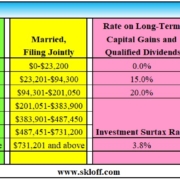How a Step-Up in Basis Can Be a Tax Dream – Part 3

Money Matters – Skloff Financial Group Question of the Month – August 1, 2024
By Aaron Skloff, AIF, CFA, MBA
Q: We read ‘How a Gift Can Be a Tax Dream or a Tax Nightmare’ Part 1 and Part 2. We also read ‘How To (Legally) Avoid Taxes When Selling Your Home’ Part 1, Part 2 and Part 3. Lastly, we read ‘How Gifting Versus Selling Your Home Can Be a Tax Dream or a Tax Nightmare’ Part 1, Part 2 and Part 3. Lastly, we read ‘How a Step-Up in Basis Can Be a Tax Dream’ Part 1 and Part 2. Can you provide strategies that combine gifting and a step-up in basis?
The Problem – A Step-Up in Basis Can Be Confusing
From income taxes to capital gains taxes to investment surtaxes in the form of the Net Investment Income Tax (NIIT), it’s no wonder the tax code is so confusing. Understanding a step-up in basis adds one more layer of confusion.
The Solution – Gifting Assets to an Elderly Parent That Names You as the Beneficiary of Those Assets When They Die
If you have assets with a low cost basis that are highly appreciated you can sell those assets and be subject to income taxes, capital gains taxes and/or investment NIIT. You could sell the assets when your income and tax rates are lower. You could hold the assets until you die, but if you have a long life expectancy, your beneficiaries may have to wait a long time. Fortunately, there are strategies that combine gifting with a step-up in basis. In the examples below you have an investment portfolio with a cost basis of $100,000 that has appreciated over multiple years to $2,100,000.
Are You Interested in Learning More?
Selling Your Assets When Your Tax Rates Are High
If you sell the investments, based on your income, you would realize a $2,000,000 long term capital gain ($2,100,000 selling price – $100,000 cost basis) at your 20% capital gains rate, resulting in $400,000 ($2,000,000 X 20%) of capital gains taxes plus NIIT of $76,000 ($2,000,000 X 3.8%). Your total taxes would be $476,000, leaving you with $1,624,000 of proceeds net of taxes – a tax nightmare. See the red (danger zone) section of the table below.
Selling Your Assets When Your Tax Rates Are Lower
If you sell the investments, based on your lower income, you would realize a $2,000,000 long term capital gain ($2,100,000 selling price – $100,000 cost basis) at your 15% capital gains rate, resulting in $300,000 ($2,000,000 X 15%) of capital gains taxes plus NIIT of $76,000 ($2,000,000 X 3.8%). Your total taxes would be $376,000, leaving you with $1,724,000 of proceeds net of taxes – a tax nightmare. See the yellow (danger zone) section of the table below.
Gifting Assets to an Elderly Parent That Names You as the Beneficiary of Those Assets When They Die
You could gift your $2,100,000 investment portfolio to your elderly parents. If they sell the investments immediately, they would be subject to capital gains and NIIT based on your $100,000 cost basis. Instead, they can name you as the beneficiary and hold the investments until they die. When you inherit the investments, your cost basis would be the fair market value at the date of their death. For simplicity, let’s assume you inherit the portfolio valued at $2,100,000. If you immediately sell the portfolio for $2,100,000, you would be exempt from taxes – a tax dream. The step-up in basis would have saved you $476,000 in taxes versus the first scenario and $376,000 versus the second scenario. See the green (ultra safe zone) section of the table below.
Click to Enlarge
Action Steps
Work closely with your Registered Investment Adviser (RIA) to reduce your taxes, and grow and preserve your wealth.
Aaron Skloff, Accredited Investment Fiduciary (AIF), Chartered Financial Analyst (CFA), Master of Business Administration (MBA) is CEO of Skloff Financial Group, a Registered Investment Advisory firm specializing in financial planning, investment management and benefits for small to middle sized companies. He can be contacted at www.skloff.com or 908-464-3060.














